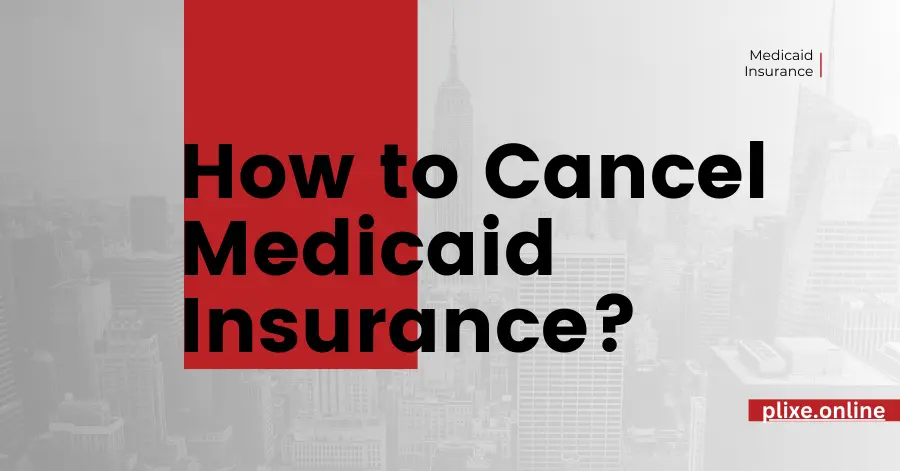When facing health insurance decisions that have to do with government programs like Medicaid insurance, it can be overwhelming. If you are switching to a new plan or you are experiencing changes to your finances or employment, canceling your ‘Medicaid insurance’ can seem daunting. But don’t worry! This guide will show you how to cancel Medicaid insurance, as well as other concerns such as getting a new insurance card Medicaid, Medicaid lost need insurance, and even insurance similar to Medicaid. At the end of this article, you will be confident and informed enough to make this decision.
Understanding How to Cancel Medicaid Insurance
It’s not as hard as it seems to cancel Medicaid insurance. It is, however, very careful and needs to be followed by specific procedures. Medicaid, a vital program for low-income individuals and families, provides access to health services. If you’re thinking of canceling, you need to know what is involved, what could happen, and what alternatives are.
Step 1: Confirm Your Reason for Cancellation
Consider whether or not to cancel before you do it. The main reasons are to get a job with employer-provided insurance, to qualify for Medicare, or health insurance like Medicaid. However, when you know your motivation, you know you’re making a wise decision that makes sense for your health, as well as your finances. It is also important to assess the potential gaps in the coverage during the transition to avoid interruptions to essential medical care. Get clarity on what that means by consulting with a healthcare advisor about the implications of canceling your current plan and exploring other options.
Step 2: Contact Your State’s Medicaid Office
Call your state’s Medicaid office and ask for the cancellation process. They may require you to:
1- Complete a Cancellation Form
The first step to formally end your Medicaid insurance coverage is to fill out a cancellation form. This makes sure you’ve documented everything correctly. Double-check the form for errors so the processing isn’t delayed.
2- Proof of New Insurance Coverage
If you are switching plans, to another plan that is like insurance like Medicaid you may be asked for proof of coverage to make sure you aren’t left without insurance. It can be the new provider or employer’s health plan. This proof is immediately to hand and saves time.
3- Submit Identification Details
You need accurate identification details such as your Medicaid ID or Social Security Number. It protects your account from unauthorized cancellations and the process is secure.
Step 3: Verify Cancellation Timeline
Know when your “Medicaid insurance” cancellation goes into effect. It’ll keep you covered if you’re switching plans. However, cancellations can take 30 days or even longer in some states. To be on the safe side, you need to check with your state’s Medicaid office to make sure that the period is exact, so as not to have unexpected gaps in coverage. Planning means you can hop on health insurance like Medicaid or other options without missing a beat in your care.
Step 4: Explore Alternative Options
That doesn’t mean you’re losing access to healthcare if you lose Medicaid. Research of insurance like Medicaid or other government subsidized plans. You may also qualify for ‘Medicaid replacement insurance’ that is designed for a specific need or demographic. Also look into Affordable Care Act (ACA) marketplace plans, which often include subsidies based on income. Low-cost or free care for people who are changing insurance plans is provided by some local community health programs. This understanding will also maintain healthcare coverage without any interruption.
What to Do If You’ve Lost Medicaid Need Insurance
Life happens and people don’t always have coverage when it’s needed because it was unforeseen. If you’ve “lost Medicaid need insurance,” here are steps to regain access to healthcare:
1- Check Eligibility for Re-enrollment: Contact your state Medicaid office if you lost Medicaid because you did not renew or did not provide documentation. Most states provide a grace period in which a person may be reinstated. Also, make sure that all personal and financial information is up to date so you don’t get thrown for a loop in the future.
2- Consider Marketplace Plans: Those who are no longer qualified for Medicaid can buy subsidized plans on the Health Insurance Marketplace. Typically, these plans provide the same type of benefits as ‘health insurance like Medicaid.’ Look at all the plans to see what works for your health and fits your budget.
3- Explore Employer-Sponsored Insurance: If you have found employment, inquire about employment-sponsored insurance options that meet your needs. Comprehensive benefits packages often include coverage for dependents, providing a stable, cost-effective solution for employers.
How to Get New Insurance Card Medicaid?
When you lose or misplace your Medicaid card, this can be stressful. Here’s how to address the issue efficiently:
Contact Your Medicaid Office:
Lose the card and report it while requesting a replacement. In many states, you can do this online, by phone, or in person. The Medicaid office can walk you through the process if you are unsure about what to do, or help you with any other assistance you may need.
Access Digital Copies:
Digital Medicaid cards are offered by some states via apps or online portals. It means you have immediate access to your information while waiting for the physical card. For online appointments or places where a physical card isn’t needed, a digital card can be used too.
Verify Your Address:
To ensure a new card doesn’t take a while to arrive, make sure your mailing address is correct. Medicaid may send a new card to an outdated address sometimes causing unnecessary delays, so it’s important to check and confirm that information before requesting a replacement.
Know Your Coverage Details:
After the issuing of your card, make note of your Medicaid ID number, and coverage details and keep them handy while waiting. It will also help healthcare providers verify your benefits if needed. Having this information on hand can keep your medical services running until they send you your new card.
Understanding Alternatives: Insurance Like Medicaid
When you’re transitioning out of Medicaid, you have to know your options. Here are some options:
1- Medicaid Replacement Insurance: Plans for people transitioning out of Medicaid are available through some private insurers. These plans are often similar with low premiums and the same benefits.
2- Marketplace Plans: The Affordable Care Act subsidizes these plans for individuals and families with moderate incomes.
3- State-Specific Programs: Supplemental programs are offered by many states for people who no longer qualify for Medicaid but still need financial help.
4- Employer-Sponsored Insurance: This is potentially the most comprehensive and inexpensive option if you’ve gained employment.
I Lost My Medicaid Insurance Card: Immediate Steps
You don’t lose access to health care just because you misplace your Medicaid insurance card. Follow these steps:
1- Contact Customer Service: Several states have a Medicaid helpline. If you report your disappeared card you’re issued a new one without delay. Make sure you keep the case number in the record just in case. You want to act quickly because you don’t want anything to interfere with your healthcare coverage.
2- Use Temporary Verification: Ask your Medicaid office to send you a temporary verification letter. Proof of coverage until your new card arrives. An additional use of the letter is to make a claim for medical services without waiting, so your benefits are protected.
3- Update Your Records: Check every personal detail, especially for future inconveniences. Part of it is physically confirming your address and contact info so that your new card gets to you pronto.
4- Be Proactive: In the future, keep a copy of your Medicaid card, either digital or photocopy. Additionally, it’s a good idea to store a copy in a secure location online that you can easily access if you need it.
Comparing Options: Health Insurance Like Medicaid
If you’re moving from Medicaid to Medicaid, you need it. Here’s what to consider:
1- Coverage Similarities: Check out plans with basic benefits such as preventative care, hospitalization, and prescriptions. If you have ongoing health needs, it’s important that the coverage very closely matches what you had with Medicaid. Make sure the new plan covers chronic conditions, specialists, and other necessary treatments and does so comprehensively.
2- Affordability: Compare premiums, deductibles, and out-of-pocket costs to make sure the plan fits in the budget. Think about how much you can afford to make on a monthly basis to put towards healthcare and what your out-of-pocket costs will be in utilizing that service. Assess the long-term affordability of the plan with regard to prescription drug costs and copayments for doctor visits.
3- Network Accessibility: Make sure that your pick of preferred healthcare providers does accept the new insurance. That’s even more true if you already are familiar with your doctors or specialists. Also, see if your hospital and pharmacy close to you are part of the plan’s network to prevent unintended costs when you go to get care.
4- Additional Benefits: A few plans add dental, vision, or mental health coverage to the table. These extra benefits will make a huge difference in your healthcare journey. Second, investigate wellness programs or reduced rates with regards to well-being joined administrations which could enable you to remain solid while keeping your complete costs down.
Avoiding Gaps in Coverage
1- Plan Ahead: Only after you are secured with alternative insurance do you initiate the cancellation process. Doing your research is a must to avoid any lapses in coverage because it’s important that you aren’t left without access to healthcare. Make sure the new plan covers what you need to be healthy and provides better or as much coverage as Medicaid does.
2- Coordinate Start Dates: Make the start date of your new plan the end date of your Medicaid coverage. By doing this, you won’t be left without coverage in the middle and there are no interruptions in your healthcare services. Tell your insurer to confirm when the new policy will be activated to aid a smooth transition.
3- Communicate with Providers: If you have a change in your insurance status, let your healthcare providers know so you don’t get billed twice. You should let them know of your new insurance details, including policy numbers and what is covered so that when they process a claim it’s done correctly. This step minimizes your risk of unexpected out-of-pocket expenses.
4- Keep Records: Keep copies of cancellation confirmation and new insurance enrollment details. This proof is that you have followed the right procedures to cancel Medicaid and secure new coverage. It also helps protect you in case discrepancies come up in billing, or continuity of coverage.
Conclusion: How to Cancel Medicaid Insurance
Canceling Medicaid insurance is a big deal that needs forethought and understanding of the options available. With this guide, you can go through the process confidently and continue to have access to healthcare. This comprehensive guide has you covered whether you’re looking into insurance like Medicaid, lost your Medicaid card and need to replace it, or you’re switching to a new plan. Always, being proactive and informed is important in managing your healthcare needs.

